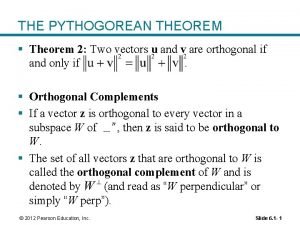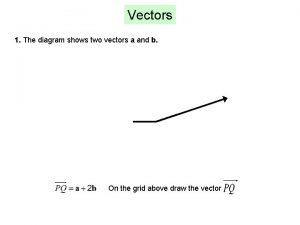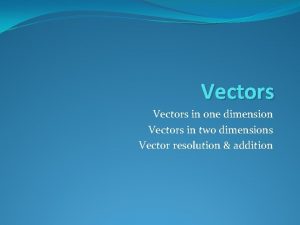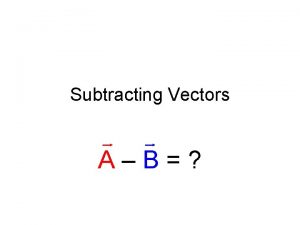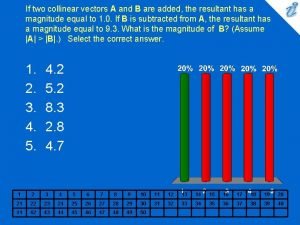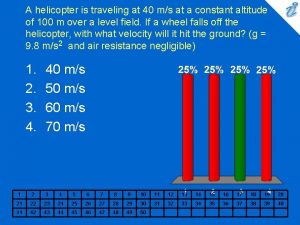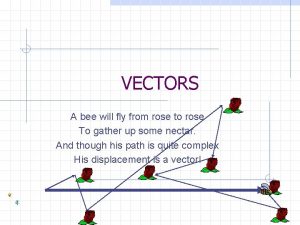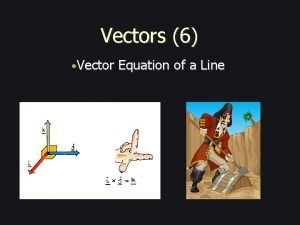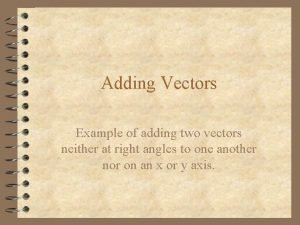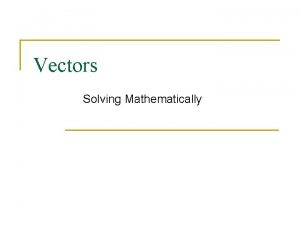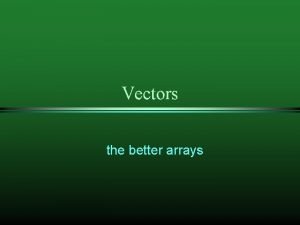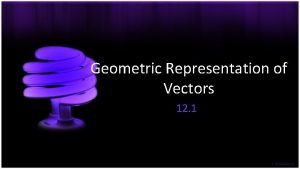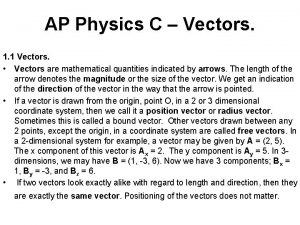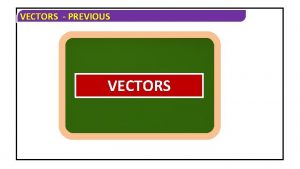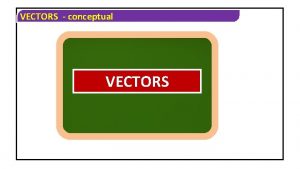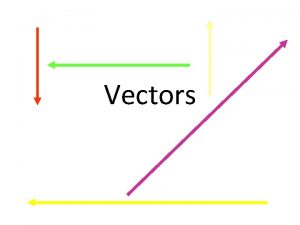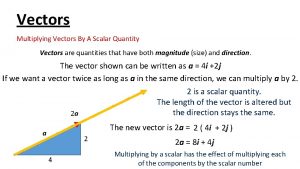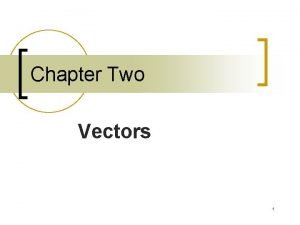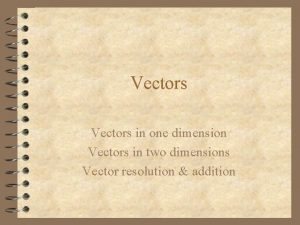THE PYTHOGOREAN THEOREM Theorem 2 Two vectors u

























- Slides: 25

THE PYTHOGOREAN THEOREM § Theorem 2: Two vectors u and v are orthogonal if and only if. § Orthogonal Complements § If a vector z is orthogonal to every vector in a subspace W of , then z is said to be orthogonal to W. § The set of all vectors z that are orthogonal to W is called the orthogonal complement of W and is denoted by (and read as “W perpendicular” or simply “W perp”). © 2012 Pearson Education, Inc. Slide 6. 1 - 1

ORTHOGONAL COMPLEMENTS 1. A vector x is in if and only if x is orthogonal to every vector in a set that spans W. 2. is a subspace of. § Theorem 3: Let A be an matrix. The orthogonal complement of the row space of A is the null space of A, and the orthogonal complement of the column space of A is the null space of AT: and © 2012 Pearson Education, Inc. Slide 6. 1 - 2

6 Orthogonality and Least Squares 6. 2 ORTHOGONAL SETS © 2012 Pearson Education, Inc.

ORTHOGONAL SETS § A set of vectors {u 1, …, up} in is said to be an orthogonal set if each pair of distinct vectors from the set is orthogonal, that is, if whenever. § Theorem 4: If is an orthogonal set of nonzero vectors in , then S is linearly independent and hence is a basis for the subspace spanned by S. © 2012 Pearson Education, Inc. Slide 6. 2 - 4

ORTHOGONAL SETS § Proof: If c 1, …, cp, then for some scalars because u 1 is orthogonal to u 2, …, up. § Since u 1 is nonzero, is not zero and so § Similarly, c 2, …, cp must be zero. © 2012 Pearson Education, Inc. . Slide 6. 2 - 5

ORTHOGONAL SETS § Thus S is linearly independent. § Definition: An orthogonal basis for a subspace W of is a basis for W that is also an orthogonal set. § Theorem 5: Let {u 1, …, up} be an orthogonal basis for a subspace W of. For each y in W, the weights in the linear combination are given by © 2012 Pearson Education, Inc. Slide 6. 2 - 6

ORTHOGONAL SETS § Proof: The orthogonality of {u 1, …, up} shows that § Since is not zero, the equation above can be solved for c 1. § To find cj for cj. © 2012 Pearson Education, Inc. , compute and solve Slide 6. 2 - 7

AN ORTHOGONAL PROJECTION § Given a nonzero vector u in , consider the problem of decomposing a vector y in into the sum of two vectors, one a multiple of u and the other orthogonal to u. § We wish to write ----(1) where for some scalar α and z is some vector orthogonal to u. See the following figure. © 2012 Pearson Education, Inc. Slide 6. 2 - 8

AN ORTHOGONAL PROJECTION § Given any scalar α, let , so that (1) is satisfied. § Then is orthogonal to u if an only if § That is, (1) is satisfied with z orthogonal to u if and only if and . § The vector is called the orthogonal projection of y onto u, and the vector z is called the component of y orthogonal to u. © 2012 Pearson Education, Inc. Slide 6. 2 - 9

AN ORTHOGONAL PROJECTION § Example 1: Let and . Find the orthogonal projection of y onto u. Then write y as the sum of two orthogonal vectors, one in Span {u} and one orthogonal to u. § Solution: Compute © 2012 Pearson Education, Inc. Slide 6. 2 - 10

AN ORTHOGONAL PROJECTION § The orthogonal projection of y onto u is and the component of y orthogonal to u is § The sum of these two vectors is y. © 2012 Pearson Education, Inc. Slide 6. 2 - 11

AN ORTHOGONAL PROJECTION § That is, § The decomposition of y is illustrated in the following figure. © 2012 Pearson Education, Inc. Slide 6. 2 - 12

AN ORTHOGONAL PROJECTION § Note: If the calculations above are correct, then will be an orthogonal set. § As a check, compute § Since the line segment in the figure on the previous slide between y and is perpendicular to L, by construction of , the point identified with is the closest point of L to y. © 2012 Pearson Education, Inc. Slide 6. 2 - 13

ORTHONORMAL SETS § A set {u 1, …, up} is an orthonormal set if it is an orthogonal set of unit vectors. § If W is the subspace spanned by such a set, then {u 1, …, up} is an orthonormal basis for W, since the set is automatically linearly independent, by Theorem 4. © 2012 Pearson Education, Inc. Slide 6. 2 - 14

ORTHONORMAL SETS § Example 2: Show that {v 1, v 2, v 3} is an orthonormal basis of , where , , § Solution: Compute © 2012 Pearson Education, Inc. Slide 6. 2 - 15

ORTHONORMAL SETS § Thus {v 1, v 2, v 3} is an orthogonal set. § Also, which shows that v 1, v 2, and v 3 are unit vectors. § Thus {v 1, v 2, v 3} is an orthonormal set. § Since the set is linearly independent, its three vectors form a basis for. See the figure on the next slide. © 2012 Pearson Education, Inc. Slide 6. 2 - 16

ORTHONORMAL SETS § When the vectors in an orthogonal set of nonzero vectors are normalized to have unit length, the new vectors will still be orthogonal, and hence the new set will be an orthonormal set. © 2012 Pearson Education, Inc. Slide 6. 2 - 17

ORTHONORMAL SETS § Theorem 6: An matrix U has orthonormal columns if and only if. § Proof: To simplify notation, we suppose that U has only three columns, each a vector in. § Let and compute ----(3) © 2012 Pearson Education, Inc. Slide 6. 2 - 18

ORTHONORMAL SETS § § Theorem 7: Let U be an matrix with orthonormal columns, and let x and y be in Then a. b. c. if and only if . Properties (a) and (c) say that the linear mapping preserves lengths and orthogonality. © 2012 Pearson Education, Inc. Slide 6. 2 - 19

6 Orthogonality and Least Squares 6. 2 ORTHOGONAL PROJECTIONS © 2012 Pearson Education, Inc.

ORTHOGONAL PROJECTIONS § The orthogonal projection of a point in onto a line through the origin has an important analogue in. § Given a vector y and a subspace W in , there is a vector in W such that (1) is the unique vector in W for which is orthogonal to W, and (2) is the unique vector in W closest to y. © 2012 Pearson Education, Inc. Slide 6. 3 - 21

THE ORTHOGONAL DECOMPOSITION THEOREM § These two properties of provide the key to finding the least-squares solutions of linear systems. § Theorem 8: Let W be a subspace of. Then each y in can be written uniquely in the form ----(1) where is in W and z is in. § In fact, if {u 1, …, up} is any orthogonal basis of W, then ----(2) and © 2012 Pearson Education, Inc. . Slide 6. 3 - 22

THE ORTHOGONAL DECOMPOSITION THEOREM § The vector in (1) is called the orthogonal projection of y onto W and often is written as proj. Wy. See the following figure. § Proof: Let {u 1, …, up} be any orthogonal basis for W, and define by (2). § Then is in W because is a linear combination of the basis u 1, …, up. © 2012 Pearson Education, Inc. Slide 6. 3 - 23

THE ORTHOGONAL DECOMPOSITION THEOREM § Let. § Since u 1 is orthogonal to u 2, …, up, it follows from (2) that § § Thus z is orthogonal to u 1. Similarly, z is orthogonal to each uj in the basis for W. Hence z is orthogonal to every vector in W. That is, z is in. © 2012 Pearson Education, Inc. Slide 6. 3 - 24

THE ORTHOGONAL DECOMPOSITION THEOREM § The uniqueness of the decomposition (1) shows that the orthogonal projection depends only on W and not on the particular basis used in (2). § Example 1: Let . Observe that {u 1, u 2} is an orthogonal basis for. Write y as the sum of a vector in W and a vector orthogonal to W. © 2012 Pearson Education, Inc. Slide 6. 3 - 25
 Great orthogonality theorem
Great orthogonality theorem Stokes theorem green's theorem
Stokes theorem green's theorem Oabc is a parallelogram p is the point on ac
Oabc is a parallelogram p is the point on ac Two dimensional motion and vectors
Two dimensional motion and vectors Examples of parallel forces
Examples of parallel forces Least square solution
Least square solution Vectors in one dimension
Vectors in one dimension The diagram shows two vectors that point west and north.
The diagram shows two vectors that point west and north. Collinear vectors
Collinear vectors How do you add two vectors algebraically
How do you add two vectors algebraically A helicopter is traveling at 40m /s
A helicopter is traveling at 40m /s Unit vector notation
Unit vector notation How to know if two vectors are parallel
How to know if two vectors are parallel Cross product of two vectors
Cross product of two vectors Adding two vectors together
Adding two vectors together Hình ảnh bộ gõ cơ thể búng tay
Hình ảnh bộ gõ cơ thể búng tay Ng-html
Ng-html Bổ thể
Bổ thể Tỉ lệ cơ thể trẻ em
Tỉ lệ cơ thể trẻ em Voi kéo gỗ như thế nào
Voi kéo gỗ như thế nào Thang điểm glasgow
Thang điểm glasgow Bài hát chúa yêu trần thế alleluia
Bài hát chúa yêu trần thế alleluia Môn thể thao bắt đầu bằng chữ đua
Môn thể thao bắt đầu bằng chữ đua Thế nào là hệ số cao nhất
Thế nào là hệ số cao nhất Các châu lục và đại dương trên thế giới
Các châu lục và đại dương trên thế giới Công thức tính thế năng
Công thức tính thế năng
